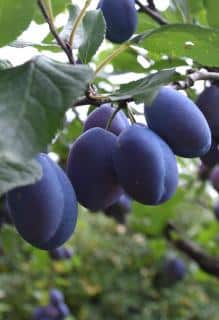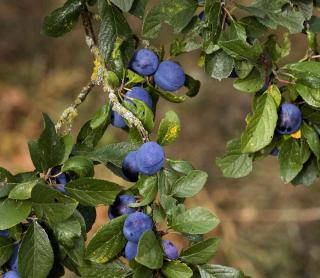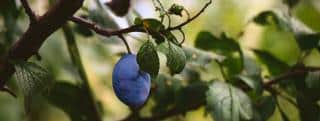

The Alsace damson plum tree is a sweet variety of damsons.
Alsace Damson (Questche) facts
Name – Prunus domestica insititia
Family – Rosaceae
Type – fruit tree
Height – 16 to 20 feet (5 to 6 m)
Exposure – full sun
Soil – rich enough
Foliage: deciduous – Flowering: early→mid spring – Harvest: summer→fall
This particular damson variety, locally called “quetsche”, is delicious and sweet, and it’s quite ornamental, too. Planting, pruning and caring for it is important to avoid diseases.
Favor planting in fall or in spring but avoid freezing temperatures.
 Remember that for all fruit trees, the best period for planting is fall, because this season has the highest success rate for root development in spring.
Remember that for all fruit trees, the best period for planting is fall, because this season has the highest success rate for root development in spring.
 It’s recommended to prune only what is strictly necessary because plum trees are delicate and wounds make it vulnerable to diseases.
It’s recommended to prune only what is strictly necessary because plum trees are delicate and wounds make it vulnerable to diseases.
After each cut, apply pruning paste like pine tar to protect the wood from fungus and other diseases.
Nonetheless, you may perform directional pruning in the first year to shape the structure of the tree. The goal here is to thin out shoots from the trunk to end up with 3 or 4 main branches facing outwards.
Like all pit trees, notably the cherry tree, pruning is performed at the end of the summer or in the beginning of fall.
Once you have harvested the plums, remove dead wood and fragile branches.
Remove fruits that haven’t fallen from the tree – they are often diseased – and destroy them.
Also, remove suckers, which are those shoots that emerge at the base of the tree.
Quetsche plums tree are fruit trees for which fruits are both eaten fresh from the tree as common damson, and preserved. This can be done in various manners such as jams, liquor, pastries or simply desiccated as dried prunes.
Plum trees are also grown as ornamental plants since their blooming is generous at the beginning of spring and their foliage stays appealing until the leaves fall off.
Fruit-bearing will be greatly enhanced if manure is added at the base of the Alsace damson plum tree in fall, and if fruit tree fertilizer is added in spring.
This rather ancient variety is one of the most famous and one of the most tasty. It is particularly sought after for its juicy and sweet flesh.
Read more about insects and diseases that attack plum trees:
 Rust – brownish-orange lesions appear on the underside of leaves.
Rust – brownish-orange lesions appear on the underside of leaves.Mulch the foot of the trunk to avoid weeds, protect roots from the cold during winter and retain moisture in the summer.